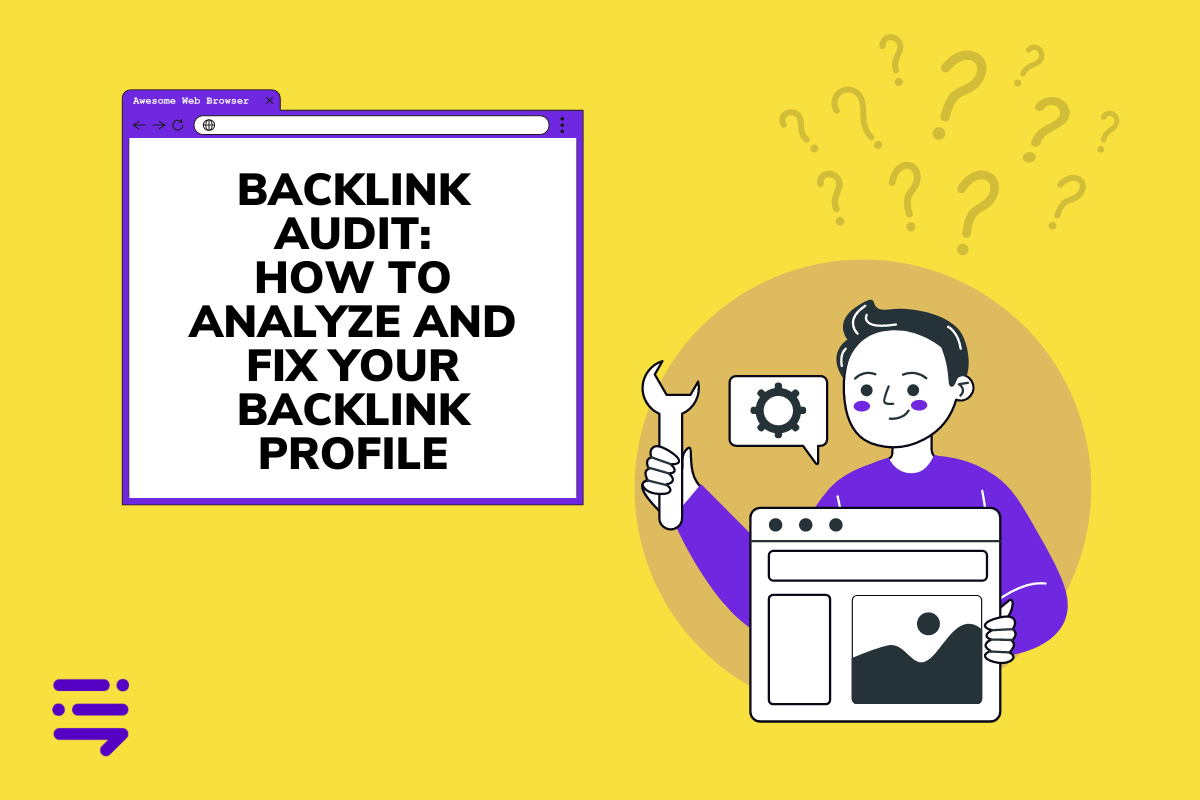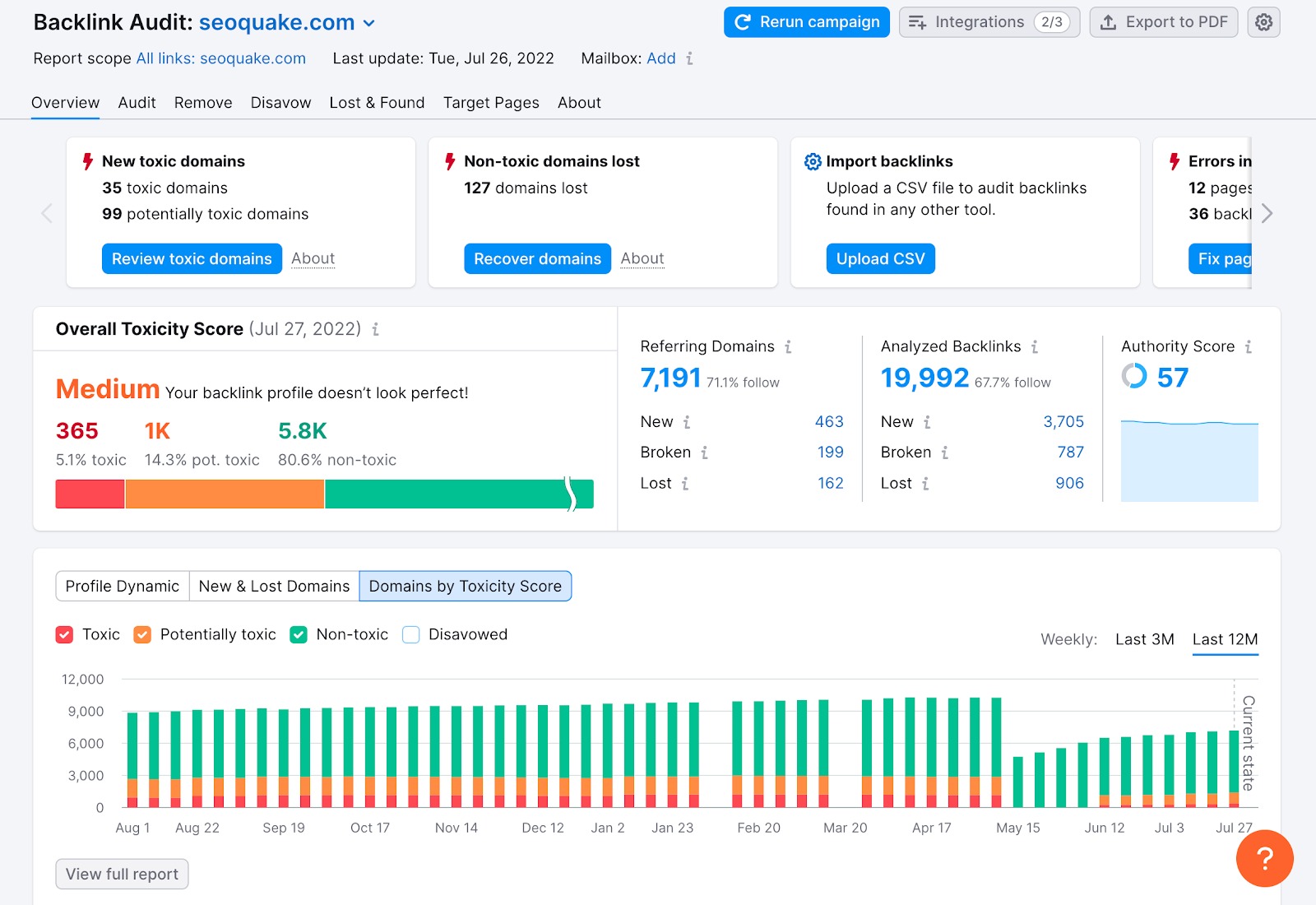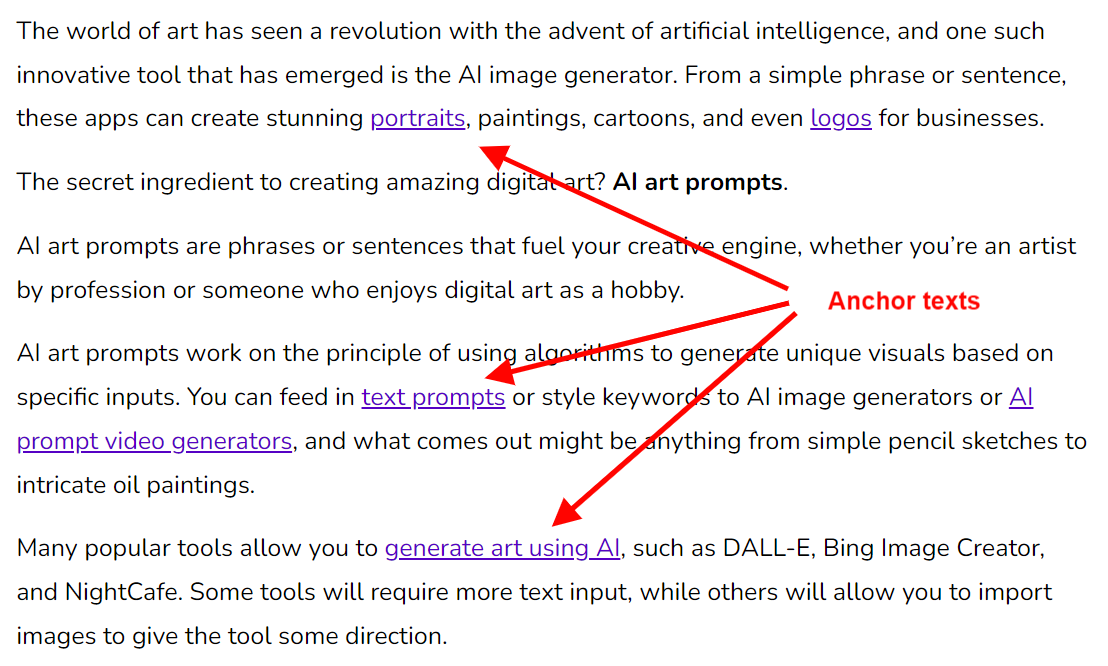Discover top guides, trends, tips and expertise from AIO Writers
Backlink Audit: How to Analyze and Fix Your Backlink Profile
Julia McCoy
Thursday, 11th Apr 2024
Ever wondered why, despite all the hard work you’ve put into creating content, your website still lags behind in Google’s search results? Well, it might just be time for a backlink audit.
This crucial step could be what’s standing between you and higher rankings. A thorough backlink audit helps identify links that lift you and those dragging you down. And here’s the kicker – not all links pointing to your site are doing you good.
Think of a backlink audit as spring cleaning; some old stuff needs to go to make room for better things. With every toxic link that gets shown the door, there’s potential for quality traffic and improved visibility on search engines.
Here’s everything you need to know about backlink audits.
Table Of Contents:
- What Is a Backlink Audit and Why Is It Important?
- How to Conduct a Thorough Backlink Audit
- Evaluating the Quality and Relevance of Your Backlinks
- Analyzing Your Anchor Text Distribution
- Comparing Your Backlink Profile to Competitors
- Dealing with Negative SEO Attacks
- Creating a Link-Building Strategy Based on Your Audit Findings
- Tools and Resources for Conducting a Backlink Audit
- FAQs – Backlink Audit
- Conclusion
What Is a Backlink Audit and Why Is It Important?
You’ve probably heard the term “backlink audit” thrown around in SEO circles. But what exactly does it mean? And more importantly, why should you care?
Let me break it down for you.
A backlink audit is essentially a deep dive into your website’s backlink profile. It’s a way to analyze the quality and quantity of links pointing to your site from other websites.
Think of it like a health check-up for your website. Just like you go to the doctor for regular check-ups to make sure everything is functioning properly, a backlink audit helps ensure your site’s link profile is in tip-top shape.
The purpose of a backlink audit is to identify any potential issues that could be hurting your search engine rankings. This could include low-quality or spammy links, links from irrelevant websites, or even links that have been created using black-hat SEO tactics.
By identifying these issues early on, you can take steps to fix them before they cause any long-term damage to your site’s SEO.
How a Backlink Audit Can Improve Your SEO
So, how exactly can a backlink audit help improve your site’s SEO?
- Identify and remove toxic links: A backlink audit can help you identify any toxic or spammy links pointing to your site. By removing these links, you can improve your site’s overall link quality and avoid any potential penalties from Google.
- Improve link diversity: A backlink audit can also help you identify any areas where your link profile may be lacking diversity. For example, if all your links are coming from the same type of website or using the same anchor text, it could be a red flag to search engines. By diversifying your link profile, you can improve your site’s overall SEO health.
- Identify link-building opportunities: In addition to identifying issues with your existing links, a backlink audit can also help you identify new link-building opportunities. By analyzing your competitors’ link profiles, you can find websites that may be willing to link to your site as well.
- Boost organic traffic: Ultimately, the goal of any SEO strategy is to increase organic traffic to your website. By improving your site’s link profile through a backlink audit, you can boost your search engine rankings and drive more targeted traffic to your site.
In short, a backlink audit is an essential part of any comprehensive SEO strategy. By regularly analyzing your site’s link profile, you can identify issues early on, improve your overall link quality, and ultimately drive more organic traffic to your site.
How to Conduct a Thorough Backlink Audit
Now that you understand the importance of backlink health tracking, let’s dive into the nitty-gritty of how to do a backlink audit.
Don’t worry, it’s not as complicated as it sounds. With the right tools and a little bit of know-how, you can perform a thorough backlink audit in no time.
Step 1: Gather Your Backlink Data
The first step in conducting a backlink audit is to gather all the data on your site’s existing backlinks. There are a variety of backlink audit tools you can use to do this, including Google Search Console, Ahrefs, and Moz Link Explorer.
These tools will give you a comprehensive list of all the websites linking to your site, along with important metrics like the linking page’s authority, the anchor text used, and the type of link (dofollow vs. nofollow).
Step 2: Analyze Your Backlink Profile
Once you have all your backlink data, it’s time to start analyzing it. This is where the real work begins.
Start by looking for any patterns or red flags in your link profile. Are a large percentage of your links coming from low-quality or irrelevant websites? Are you seeing a lot of links with overly optimized anchor text? These could be signs of a problem.
You should also look at the overall diversity of your link profile. A healthy link profile should have a mix of different types of links from a variety of different websites.
Step 3: Identify Toxic or Spammy Backlinks
One of the most important things to look for during a backlink audit is any toxic or spammy links pointing to your site. These are links that come from low-quality or irrelevant websites, often created using black-hat SEO tactics.
Some common signs of a toxic link include:
- Links from websites with thin or low-quality content
- Links from websites that are not relevant to your niche or industry
- Links with overly optimized anchor text (e.g. “buy cheap Viagra”)
- Links from websites that have been penalized by Google in the past
If you identify any toxic links during your audit, it’s important to take steps to remove them as soon as possible. You can do this by reaching out to the website owner and asking them for a backlink removal, or by using Google’s disavow tool to tell Google to ignore the link.
Step 4: Check for Manual Actions or Penalties
In addition to identifying toxic links, it’s also important to check for any manual actions or penalties that may have been applied to your site by Google.
A manual action is a penalty that is applied to a website by a member of Google’s webspam team. This usually happens when a website is found to violate Google’s webmaster guidelines, such as by participating in link schemes or using black-hat SEO tactics.
If you suspect that your site may have been hit with a manual action, you can check your Google Search Console account for any messages or notifications. If you do find a manual action, you’ll need to take steps to fix the issue and submit a reconsideration request to Google.
By regularly conducting thorough backlink audits and taking steps to fix any issues that are identified, you can help ensure that your site maintains a healthy and diverse link profile that will help boost your search engine rankings and drive more organic traffic to your site.

Evaluating the Quality and Relevance of Your Backlinks
Not all backlinks are created equal. Some can skyrocket your rankings, while others can tank your SEO faster than you can say “Google penalty.”
So how do you tell the difference?
Assess Referring Domain Authority
First up, let’s talk about the authority of the websites linking to you. This is measured by metrics like Domain Authority (DA) from Moz or Domain Rating (DR) from Ahrefs.
Generally, the higher the authority score, the more valuable the link. A single link from a DA 90+ website can be worth more than dozens of links from low-authority domains.

But don’t get too caught up in the numbers game. As Google’s John Mueller pointed out, Google doesn’t use any specific DA metric. It’s more about the overall quality and relevance of the linking domain.
Examine Backlink Relevance
The next factor to assess is backlink relevance. A link from a website in your niche is worth far more than a link from a completely unrelated site.
For example, if you run a fitness blog, a link from a major health publication would be highly relevant and valuable. A link from a random gambling site? Not so much.
Relevant links help establish your site’s authority and expertise in your field. They signal to Google that others in your industry view your content as valuable and worth referencing.
Identify High-Value Backlinks
So what does a high-value, quality backlink look like? Here are a few key characteristics:
- It comes from a high-authority, trusted website.
- The linking domain is relevant to your niche.
- The link is contextual, meaning it’s surrounded by relevant content.
- The anchor text is natural and relevant, not stuffed with keywords.
- It’s a “dofollow” link, meaning it passes link equity.
On the flip side, low-quality or spammy backlinks often have the opposite traits: they come from low-authority, irrelevant domains, use overly optimized anchor text, and may be part of link schemes or private blog networks (PBNs).
Identifying and prioritizing your high-value backlinks is crucial for assessing your overall link profile health and identifying new link-building opportunities.
Analyzing Your Anchor Text Distribution
Anchor text – the clickable words used to link to your site – is another key factor to analyze in your backlink audit.
Why? Because your anchor text distribution can either help or hurt your SEO.

Back in the early days of SEO, it was common practice to cram exact-match keywords into anchor text. So if you wanted to rank for “best dog toys,” you’d try to get a bunch of links with that exact phrase as the anchor text.
But those days are long gone. Now, having too many exact-match anchors can trigger a Google penalty for “unnatural linking.”
For example, if 70% of your backlinks use the same “money keyword” as the anchor text, that’s a sign of over-optimization.
When analyzing your anchor text distribution, keep an eye out for:
- An unnaturally high percentage of exact-match keywords
- Anchor text that doesn’t fit the context of the linking page
- Anchors that are stuffed with irrelevant or spammy keywords
If you spot any of these issues, it’s worth reaching out to the linking site and requesting an anchor text change. Or, in the case of clearly spammy links, you may want to consider disavowing them.
The goal is to have a natural, diverse anchor text profile that reflects how real people would link to your content.
You want a mix of:
- Branded anchors (your brand or website name)
- Partial-match keywords (“dog toys” instead of “best dog toys”)
- Generic phrases (“click here,” “read more,” etc.)
- Naked URLs (https://www.yoursite.com)
- Natural, editorial phrases (“according to a study by …”)
A diverse anchor text profile is a strong signal of natural, editorial links — the kind Google loves to see.
Comparing Your Backlink Profile to Competitors
You know what they say – keep your friends close, and your enemies closer. In the world of SEO, that means keeping a close eye on your competitors’ backlink profiles.
Why? Because by analyzing their linking strategies, you can uncover golden opportunities to boost your own rankings and traffic.
Identify Competitor Backlink Opportunities
First things first – you need to know who your top competitors are in the search results. Once you’ve got that list, it’s time to dive into their backlink data using the best link-building tools.
What you’re looking for are high-quality, relevant websites that are linking to your competitors but not to you. These could be industry blogs, resource pages, or even news sites covering your niche.
Make a list of these potential link opportunities and start brainstorming ways to get your own links from those sources. Maybe you could contribute a guest post, offer an exclusive interview, or create a valuable resource they’d want to link to.
Analyze Competitor Linking Strategies
But don’t stop there – take a closer look at your competitors’ overall linking strategies. Are they focusing on certain types of content? Targeting specific anchor texts? Getting links from particular types of websites?
By understanding the patterns and tactics behind their link-building success, you can adapt and improve upon those strategies for your own site.
For example, if you notice a competitor getting lots of links from industry roundup posts, consider reaching out to those same bloggers and offering your own expert insights.
Or if you see them successfully leveraging broken link building, start scouring relevant resource pages for dead links you could replace with your own content.
The key is to not just copy your competitors’ tactics but to analyze why they’re working and find creative ways to put your own unique spin on them.
Dealing with Negative SEO Attacks
Sometimes, a website could fall victim to a negative SEO attack, where a competitor (or just a hater) intentionally points a bunch of toxic links to your site to tank your rankings.
How can you tell if you’re under attack? Here are a few signs to watch out for:
- A sudden influx of spammy, irrelevant links pointing to your site
- A big jump in your total number of referring domains, especially from low-quality sources
- Links coming from known “bad neighborhood” sites like porn or gambling sites
- Unusual anchor text distribution, like a surge in exact match keywords
Tools like Ahrefs Alerts can help you identify negative SEO attacks like these:

If you spot any of these red flags, it’s time to take action before your rankings take a nosedive.
The first step is to identify all the spammy and toxic links pointing to your site.
Once you’ve got your list of bad links, it’s time to disavow them. This tells Google to ignore those links when evaluating your site’s link profile.
But be careful — disavowing the wrong links could hurt your rankings. Only disavow links that are clearly spammy or irrelevant.
If you’re not confident in your disavowing skills, consider hiring an SEO professional to help you clean up your link profile safely and effectively.
Learn how to outsource link building and management here.
The key is to stay vigilant and proactive in monitoring your backlink profile for any signs of trouble. By regularly auditing your links and quickly addressing any toxic ones, you can protect your site from negative SEO attacks and maintain a healthy, high-performing link profile.
Creating a Link-Building Strategy Based on Your Audit Findings
So you’ve done your backlink audit, and now you’re ready to take action. But where do you start?
Step 1: Identify Link Building Opportunities
First things first, take a close look at your audit results to identify potential link-building opportunities. These could be:
- High-quality, relevant websites in your niche that aren’t linking to you yet
- Broken links on other sites that you could replace with your own content
- Unlinked brand mentions that you could reach out and request a link for
- Competitors’ backlinks that you could potentially acquire for your own site
Make a list of these opportunities and prioritize them based on factors like domain authority, relevance, and ease of acquisition. The low-hanging fruit – easy wins that could have a big impact – should be at the top of your list.
Step 2: Create a Targeted Outreach Plan
Now that you know who you want to target, it’s time to create a link-building outreach plan. This is where you’ll determine how you’ll approach each opportunity and what you’ll offer in exchange for a link.
Your outreach strategy might include:
- Guest posting on relevant blogs and websites
- Reaching out to webmasters about fixing broken links with your content
- Requesting links for unlinked brand mentions
- Offering to replace competitors’ links with your own (only for non-competing sites)
The key is to tailor your approach to each opportunity and offer something of value in return. No one wants to give out links for free, so make sure you’re providing quality content, useful resources, or other incentives.
Step 3: Monitor Your Link Building Progress
Link building is an ongoing process, not a one-and-done task. As you execute your strategy, it’s crucial to monitor your progress and adjust your approach as needed.
Use tools like Google Search Console to track your backlink profile growth over time. Keep an eye on metrics like:
- Total number of backlinks and referring domains
- Domain authority of linking sites
- Anchor text distribution
- Ratio of follow vs. nofollow links
If you’re not seeing the results you want, don’t be afraid to pivot your strategy. Try new outreach tactics, target different opportunities, or adjust your offerings. The key is to stay agile and adaptable as you build your link profile.
Tools and Resources for Conducting a Backlink Audit
Conducting a thorough backlink audit is crucial, but it can also be time-consuming and complex. Fortunately, there are plenty of tools and resources available to streamline the process and provide valuable insights.
Here are a couple of the top options to consider:
Google Search Console
Google Search Console (GSC) is a free tool provided by Google that offers a wealth of information about your website’s performance and backlink profile. While it may not be as comprehensive as some paid tools, it’s a great starting point for any link audit.
In the “Links” section of GSC, you can see:
- Total number of external links pointing to your site
- Top linking sites and pages
- Most common anchor text used in your backlinks
- Internal links within your own website
This information can help you identify potential issues like over-optimized anchor text or low-quality linking sites. It can also reveal opportunities for internal linking optimization.
Best of all, because the data comes directly from Google, you know it’s accurate and up-to-date. So while it may not be the only tool you use for your audit, GSC should definitely be in your arsenal.
Third-Party Backlink Audit Tools
While Google Search Console is a solid foundation, third-party tools can provide even more detailed insights and analysis for your link audit. Some popular options include:
- Ahrefs
- Moz Link Explorer
- Semrush
- Majestic
These backlink audit tools can help you dive deeper into your backlink profile with features like:
- Identifying toxic or spammy links
- Analyzing anchor text distribution
- Comparing your backlink profile to competitors
- Tracking new and lost links over time
Many of these tools also offer additional features beyond just link analysis, such as keyword research, site audits, and content analysis. So while they may come with a price tag, the insights and efficiency they provide can be well worth the investment.
FAQs – Backlink Audit
What is a backlink audit?
A deep dive into your site’s inbound links to weed out the bad and spotlight the good, boosting SEO.
How long does a backlink audit take?
It varies. Small sites may need a few hours, while larger ones could take weeks for a thorough inspection.
How do you conduct a link audit?
Gather all your backlinks, check their quality and relevance, and then toss or keep them accordingly. Rinse and repeat regularly.
How do you vet and audit backlinks?
Analyze each link’s authority score and relevance to your content; ditch any that look shady or off-topic.
Conclusion
Conducting regular backlink audits is not just a task to check off your SEO to-do list — it’s a strategic necessity for maintaining a healthy and thriving online presence. By leveraging backlink analysis tools like Semrush, Ahreds, or Moz, you can identify and eliminate toxic links that may be dragging down your website’s performance, while also uncovering valuable opportunities to strengthen your backlink profile.
Remember, in the ever-evolving landscape of search engine optimization, staying vigilant and proactive with your backlink strategy is key to staying ahead of the competition and securing long-term success for your website. So, roll up your sleeves, dive into your backlink profile, and let the audit process propel your SEO efforts to new heights.

UNLOCK YOUR POTENTIAL
Long Headline that highlights Value Proposition of Lead Magnet
Grab a front row seat to our video masterclasses, interviews, case studies, tutorials, and guides.



